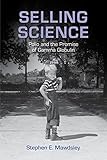Selling Science : Polio and the Promise of Gamma Globulin / Stephen E. Mawdsley.
Material type: TextSeries: Critical Issues in Health and MedicinePublisher: New Brunswick, NJ : Rutgers University Press, [2016]Copyright date: ©2016Description: 1 online resource (231 p.) : 14 photographs, 3 maps, 4 figuresContent type:
TextSeries: Critical Issues in Health and MedicinePublisher: New Brunswick, NJ : Rutgers University Press, [2016]Copyright date: ©2016Description: 1 online resource (231 p.) : 14 photographs, 3 maps, 4 figuresContent type: - 9780813574417
- 614.5/490973 23
- RA644.P9 M39 2016
- online - DeGruyter
| Item type | Current library | Call number | URL | Status | Notes | Barcode | |
|---|---|---|---|---|---|---|---|
 eBook
eBook
|
Biblioteca "Angelicum" Pont. Univ. S.Tommaso d'Aquino Nuvola online | online - DeGruyter (Browse shelf(Opens below)) | Online access | Not for loan (Accesso limitato) | Accesso per gli utenti autorizzati / Access for authorized users | (dgr)9780813574417 |
Frontmatter -- Contents -- Illustrations -- Acknowledgments -- Abbreviations -- Introduction -- Chapter 1. Forging Momentum -- Chapter 2. Building Consent for a Clinical Trial -- Chapter 3. Marketing and Mobilization -- Chapter 4. The Pilot Study -- Chapter 5. Operation Marbles and Lollipops -- Chapter 6. The National Experiment -- Notes -- Bibliography -- Index
restricted access online access with authorization star
http://purl.org/coar/access_right/c_16ec
Today, when many parents seem reluctant to have their children vaccinated, even with long proven medications, the Salk vaccine trial, which enrolled millions of healthy children to test an unproven medical intervention, seems nothing short of astonishing. In Selling Science, medical historian Stephen E. Mawdsley recounts the untold story of the first large clinical trial to control polio using healthy children—55,000 healthy children—revealing how this long-forgotten incident cleared the path for Salk’s later trial. Mawdsley describes how, in the early 1950s, Dr. William Hammon and the National Foundation for Infantile Paralysis launched a pioneering medical experiment on a previously untried scale. Conducted on over 55,000 healthy children in Texas, Utah, Iowa, and Nebraska, this landmark study assessed the safety and effectiveness of a blood component, gamma globulin, to prevent paralytic polio. The value of the proposed experiment was questioned by many prominent health professionals as it harbored potential health risks, but as Mawdsley points out, compromise and coercion moved it forward. And though the trial returned dubious results, it was presented to the public as a triumph and used to justify a federally sanctioned mass immunization study on thousands of families between 1953 and 1954. Indeed, the concept, conduct, and outcome of the GG study were sold to health professionals, medical researchers, and the public at each stage. At a time when most Americans trusted scientists, their mutual encounter under the auspices of conquering disease was shaped by politics, marketing, and at times, deception. Drawing on oral history interviews, medical journals, newspapers, meeting minutes, and private institutional records, Selling Science sheds light on the ethics of scientific conduct, and on the power of marketing to shape public opinion about medical experimentation.
Mode of access: Internet via World Wide Web.
In English.
Description based on online resource; title from PDF title page (publisher's Web site, viewed 02. Jun 2024)


